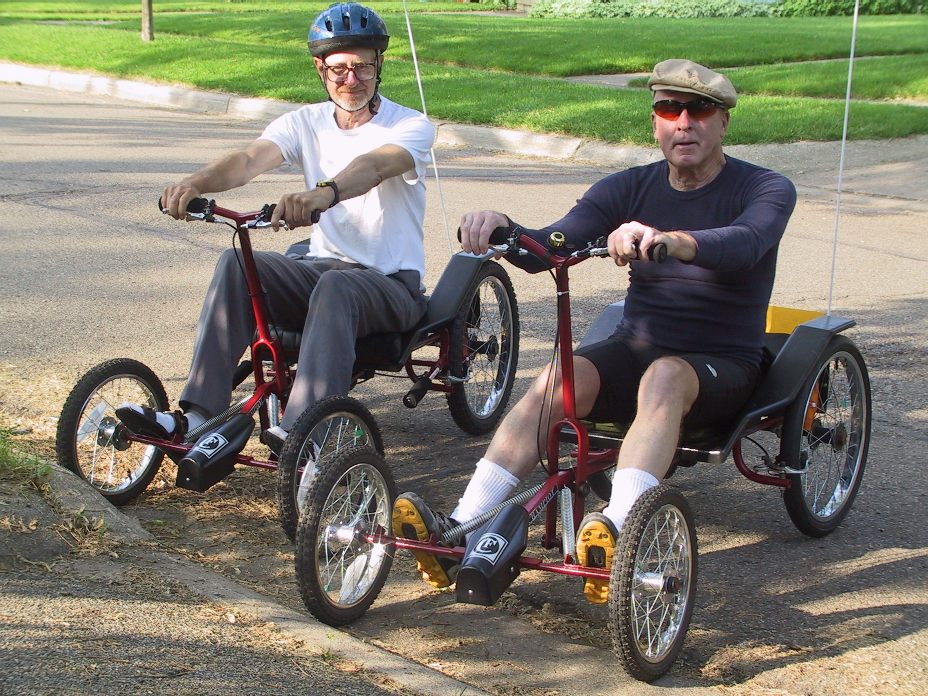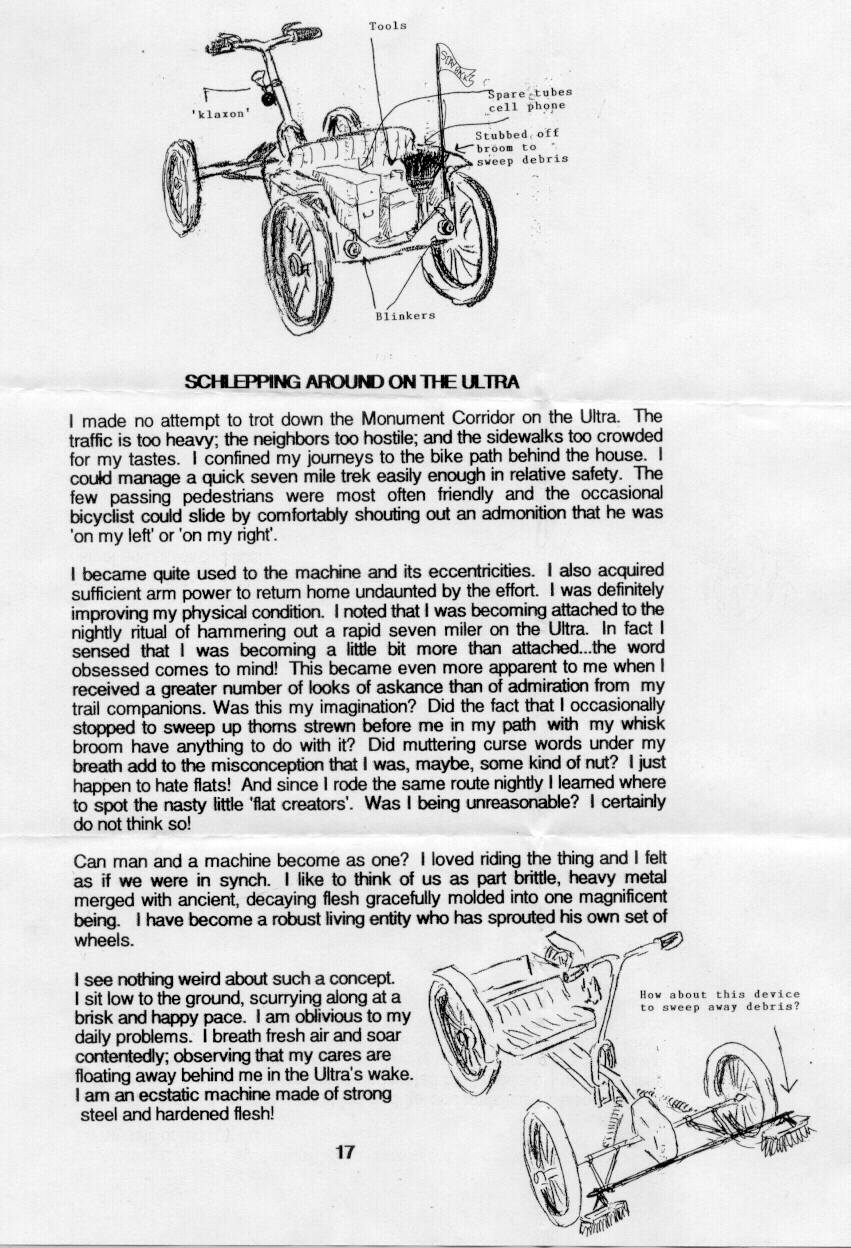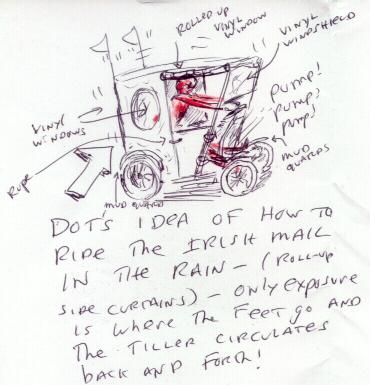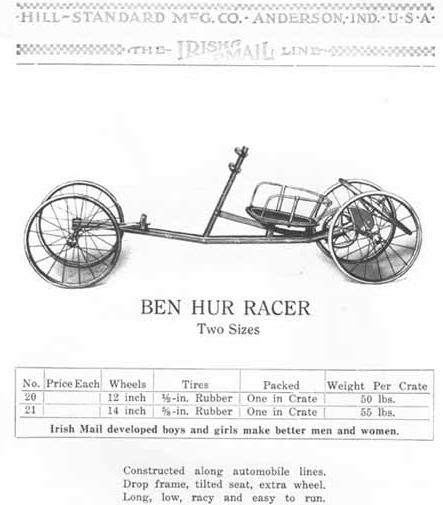
The first recumbent, as far as I can tell, was the velocipede, which evolved into the Irish Mail. Early velocipedes were used on railroads. The word velocipede was also applied earlier to a vehicle of Frenchmen Blanchard and Mazurier, introduced in 1779, consisting of a vehicle with two wheels connected by a horizontal bar, but that was a different velocipede. The rider sat on the bar and moved forward by pushing backward with the feet, much like a bicycle without a crank. Of course that velocipede was not a recumbent.
Here is a link to a photo of a restored (railroad) velocipede:
http://www.bretl.com/Mid%20Continent%20RR%20Gallery/pages/Velocipede.htm
They were ridden by railroad inspectors who rode slowly and being so close to the rails, had a good view of any problems, which would then be reported and repaired. Railroad handcars were also used, which were large enough to carry a small crew to make repairs on the spot.
I am not sure how the terminology "Irish Mail" came to be. One explanation I have seen is that the terminology came from railroad handcars or velocipedes. Railroad work camps were highly populated by Irish immigrants, so maybe the word "Irish" came from that. Perhaps the terminology goes back to the train, the Irish Mail, from the 1800's that delivered mail in Ireland. In Germany "Irish Mails" are called "Dutch Mails." I have also heard them called that in the U.S. A neighbor's elderly mother once told me that she remembered mailmen delivering mail with Irish Mails in Baltimore when she was a child. They had boxes attached at the backs of the seats for carrying the mail. Irish Mails were popular children's toys in the early 1900's.
When I was a youngster my brother and I shared an Irish Mail. The Irish Mail stayed in the family and my children rode it when they were little. My youngest, when he had his leg in a cast, cruised around town on the Irish Mail. That would be faster and more fun than crutches or a wheelchair. The original family Irish Mail was damaged in a fire, and I found it easier and cheaper to buy a replacement on ebay rather than to continue the process of trying to restore it. Here is the Irish Mail I bought on ebay. It is similar to the family Irish Mail. It is from about 1900 and all original, including the original leather tires:

Interest seemed to be diminishing, perhaps because of the cost, before the Great Depression, and the major manufacturer Hill-Standard finally went out of business during the depression. Irish Mails never returned to the popularity they once enjoyed, and still deserve. Thanks to Dr. Marcio Ferez perhaps these marvelous vehicles will make a comeback.
Below is a photo of an Irish Mail recently made by Ferez Industries in Miami, Florida. It is called the Champiot Ultra.
I should mention that there are other options for rowing on wheels such as the very nice rowbike by Scott Olson, which is more like a Concept II rowing ergometer on wheels, and the Thys rowing machine, an efficient and fast rowing-on-wheels machine. However, I want to restrict my discussion to my experience with the Ultra. When the camera clicked I was just starting up the driveway. I was beginning a pull with the arms and push with the legs.

Riding a bike or trike is mostly a lower body exercise. The Irish Mail gives an upper body workout so it makes a good complementary exercise to go along with cycling. You steer with your feet. You brace yourself by pushing with your legs as you pull, and the seat holds you in place as you push with your arms and upper body. Although they don't move much, the legs also work when you ride an Irish Mail. Just try doing a long ride on the Ultra and then cycling immediately afterward and you'll be convinced. If you hold your upper body still and only use the arms, you are using a small portion of the power available to you. Unless going downhill people end up doing a small rocking motion, using more of the upper body as they push and pull. This is especially true going up a hill. My advice is to start out slowly and keep it short the first few rides unless you are already a rower. I try to keep the back as straight as possible and do the bending at the hips, not waist.
Between 12 and 14 mph on the level is very comfortable for me. It is a good workout going up hills, and it rolls very nicely on the level and downhills. I ride mostly on paths and river trails and I am already going a little faster than I should for those conditions.
The cost is just under $600 right now, plus shipping (about $60 to Michigan, about $75 to California.)
Along with the usual spare tubes and tire tools, you want to carry a small adjustable wrench because when changing a rear tube it is easier if you first remove a brake pad.
Here is a link to the website of Ferez Industries, makers of the Champiot Ultra model as above. As you will see at their website, they also make a model for paraplegics. The Ultra model shown above and the model for paraplegics were developed by Dr. Marcio Ferez and his son, Dr. Marcio Ferez Jr.:
The Ultra might be of special interest to anyone who is having knee problems since the legs get a good workout with very little movement. Strengthening the upper body could help someone with back problems.
Another feature is that it makes an excellent vehicle for cold weather riding, and as with a trike a little snow and ice do not present a problem of an ice patch causing a spill. I think most people burn more calories while rowing compared to cycling, but of course that depends on the effort you make. The Ultra also makes a nice vehicle for running errands if you live in an area where there are sidewalks and bike paths. You see there is a compartment in back for holding groceries, etc. I also find most car drivers are friendly to me, and often stop and wave me through intersections.
Another nice thing about the Champiot Ultra is that there is no learning curve. You just get on and everything is obvious. Everybody who tries it gets the famous "recumbent grin."
I find the simplicity of the design to be elegant and stunning, like the precursor velocipede.
I have put a lot of miles on mine, and it is performing wonderfully. I highly recommend it.
A note or two on assembly and maintenance.
Here I am with my brother Allen on Ultras during his recent visit from California. We don't have to share anymore since I have two Ultras. Al now has his own Ultra in California. He tells me he is swimming faster since he has been riding his Ultra. Al doesn't have his helmet on for the photo. I recommend wearing a helmet, even though I've never spilled.

A recent note from brother Allen, waxing philosophically on his Irish Mail by Ferez Industries:

Update to Allen's missive: Allen reports that after switching the tires to Maxxis Hookworms, front and back, that he has not had any flat tires. I also have not had any more flat tires since switching to the Hookworm tires.
My sister-in-law, Allen's wife Dorothy, was worried about Allen getting caught in the rain, and she suggested a canopy. Here is Allen's sketch of the concept. Rube Goldberg and Heath Robinson, step aside:

Here are more links to velocipedes and handcars
http://www.kshs.org/cool3/velocipede.htm
http://www.ausbcomp.com/~bbott/winrr/wrrwhc.htm
Here is a neat photo sent by Donna Gore of her great-grandfather Hezekiah Clay Gore (he died in 1916). He lived and worked in Alabama in a little town called Irondale.
Here is another great photo sent by Donna. It is of Julian Rutherford,in an interesting wheelchair. Julian was an uncle of Donna's grandmother Ruth. Donna believes the photo was taken sometime between 1890 and 1900.
The Petersen Automotive Museum used to have a photo of an Irish Mail from the Hill-Standard Company. According to that reference, and also by some correspondence I've had with his great-granddaughter, Hugh Hill held some patents for the Irish Mail in the early 1900's. Hill-Standard was the major manufacturer in those days. Unfortunately the link to the photo of a Hill-Standard Irish Mail no longer works.
Here is an ad for the Ben Hur Racer from the Hill-Standard Company:
